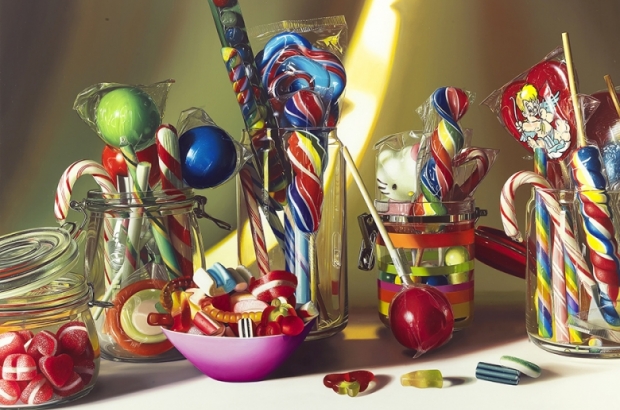- Daily & Weekly newsletters
- Buy & download The Bulletin
- Comment on our articles
The magic of the everyday: Ixelles museum casts a look at photorealism
"They're using the photograph – they're being very open about it. It's photographic realism. I don't know, photorealism. Does that sound good to you?"
The words of the writer and art dealer Louis K Meisel, talking to the art critic Howard Smith in Manhattan in 1969. It turned out to be a good name for the work of a group of US painters with links to the Meisel Gallery.
Back in 1963, Robert Bechtle was one of the first to come up with a work that would later be dubbed "photorealist". The work of the first generation of photorealists took the form of distinctive still lifes produced in the US after the Second World War. The consumer society was flourishing and in their canvases, artists depicted skyscrapers reflected in gleaming Chryslers.
Images from magazines about cars were raised to the level of art. In Tom Blackwell's work, for example, shop windows and cars are recurrent themes, as in his Sequined Mannequins (1985). Reflections in shop windows continued to arouse his interest even after 2000, as we can see in paintings such as Broadway and Perla, Madison Ave., NYC.
He wasn't the only one to be turned on by reflective surfaces: in 1969, Richard Estes painted Car Reflections, in which the blue of the sky and the blue of a car bonnet form an almost uniform field of colour, while the chrome reflects a building on the other side of the street. Ralph Goings frequently painted the interiors of cafes and bars; his oeuvre includes precisely depicted still lifes like America's Favourite (1989), in which a number of table requisites such as tabasco and a bottle of Heinz ketchup stand alongside each other on a table.
Creating a work of photographic perfection is labour-intensive: photorealists often work for eight to 10 hours at a time, observed Louis K Meisel in an interview with the cultural expert David Lubin. Which leaves very little time for drinking and partying. "That may have made them boring to people who expect artists to be troubled and dissolute. Because you go back to the pop artists, and it was all about the drug culture. The abstract expressionists were all about drinking and having beer and booze parties. The photorealists came along, and they weren't like that. They were just kind of quiet."
Conjuring with paint
The "Photorealism: 50 Years of Hyperrealistic Painting" show is a travelling exhibition, put together by the curator Otto Letze. The works in question have already been seen in the Kumu Art Museum of Estonia in Tallinn and from October they will be on display in the Osthaus Museum Hagen in Germany.
This is not the first time the Museum of Ixelles has staged an exhibition of "hyperrealist" work. In 2014, it presented an exhibition of hyperrealist sculpture by Duane Hanson. The curator of the current exhibition has divided the 34 artists on show into three generations. In what he calls the "third generation", he has included a number of European artists, including the Italian painter Roberto Bernardi, who has created dozens of compositions depicting sugary sweets that cannot – or can only just about – be distinguished from photographs.
The Dutch artist Tjalf Sparnaay learned the tricks of the trade as a designer of picture postcards for Art Unlimited: an image has to make an instant impression, otherwise it's no good. A decidedly commercial way of thinking, but he learned a lot from it, he recalls in the documentary Getting Closer, in which he stresses how it taught him to think about how images affect people. His lifelike fried egg and hamburger are impossible to forget, and his modern version of Vermeer's milkmaid stays in your mind too. His Fleamarket Milkmaid seems to be covered with a shiny layer of plastic, as if you had bought a wrapped reproduction at a flea market. "I want to impress someone with what he already knows; then you're a conjurer with paint, with illusion," believes Sparnaay.
Make it your own
Why do photorealists strive for that photographic perfection? Why do they go to so much trouble for something you could also achieve with a single click on a camera? Those are questions that arise spontaneously. Tom Blackwell provides an answer in his artist statement. During the painting process, he believes, a new image comes into being, in its own right. "To paint each area is to make it your own... Painting is a way of appropriating and also embracing reality."
Is it cheating to copy a photograph? Absolutely not. "Far from cheating, I have discovered that translating the image from the photograph requires the most intense discipline and that limiting the arena of self-expression also refines it. Working from the photograph requires a new kind of invention – an invention of means rather than of forms."
In an interview with the San Francisco Museum of Modern Art, photorealism's founding father Robert Bechtle made much the same point: the state of extreme concentration in which he makes a painting gives it something extra that a photograph will never have. "My rather naive and romantic theory is that that intensity is very psychological. And it gets embedded in the painting, in a way that people looking at the painting don't know that it's there, but it affects how they read the painting."
Photorealism, 50 Years of Hyperrealistic Painting, until 25 September at Musée d'Ixelles. Free opening night to the public on 29 June, 18.30-21.00.
Photo courtesy Bernarducci Melsel Gallery, New York. Text courtesy of Bruzz.be









